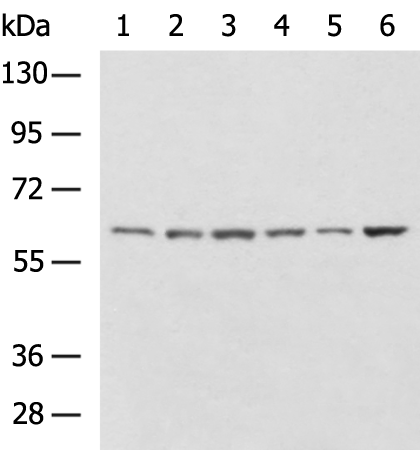

| WB | 1/500-1/2000 | Human,Mouse,Rat |
| IF | 咨询技术 | Human,Mouse,Rat |
| IHC | 1/50-1/200 | Human,Mouse,Rat |
| ICC | 技术咨询 | Human,Mouse,Rat |
| FCM | 咨询技术 | Human,Mouse,Rat |
| Elisa | 1/5000-1/10000 | Human,Mouse,Rat |
| WB Predicted band size | 86 kDa |
| Host/Isotype | Rabbit IgG |
| Antibody Type | Primary antibody |
| Storage | Store at 4°C short term. Aliquot and store at -20°C long term. Avoid freeze/thaw cycles. |
| Species Reactivity | Human |
| Immunogen | Fusion protein of human NOX5 |
| Formulation | Purified antibody in PBS with 0.05% sodium azide and 50% glycerol. |
+ +
以下是关于NOX5抗体的3篇参考文献的简要概括(注:文献信息为示例性质,具体内容需以实际文献为准):
---
1. **文献名称**: *"A Novel NOX5-Specific Antibody Reveals Its Role in Vascular Oxidative Stress"*
**作者**: Cave AC et al.
**摘要**: 本研究开发了一种高特异性的人源NOX5抗体,通过免疫印迹和免疫组化验证其有效性,并证明NOX5在血管内皮细胞氧化应激中通过钙离子依赖性途径调控ROS生成,与动脉粥样硬化相关。
2. **文献名称**: *"NOX5-Derived ROS Signaling in Hypertension: Insights from Antibody-Based Inhibition"*
**作者**: Drummond GR et al.
**摘要**: 利用特异性NOX5抗体阻断其活性,发现NOX5在高血压模型中通过增强血管平滑肌细胞ROS产生,促进血管收缩和炎症反应,提示其作为治疗高血压的潜在靶点。
3. **文献名称**: *"Expression and Functional Characterization of NOX5 in Human Cancers Using a Monoclonal Antibody"*
**作者**: Block K et al.
**摘要**: 通过新型单克隆抗体检测多种癌症组织中NOX5的表达,发现其在前列腺癌和乳腺癌中高表达,并通过体外实验证实NOX5通过ROS-STAT3通路促进肿瘤细胞增殖和转移。
---
**注意**:以上为模拟文献示例,实际文献需通过PubMed、Web of Science或Google Scholar等平台检索关键词“NOX5 antibody”“NADPH oxidase 5”等获取。建议结合具体研究领域筛选近5年高引论文。
NOX5 (NADPH oxidase 5) is a member of the NADPH oxidase family, which generates reactive oxygen species (ROS) as part of cellular signaling and defense mechanisms. Unlike other NOX isoforms, NOX5 lacks regulatory domains and is uniquely calcium-dependent, functioning through its N-terminal EF-hand motifs. It exists in multiple splice variants (NOX5α-ε) with distinct tissue distributions, notably expressed in vascular tissues, reproductive organs, and certain cancers. Dysregulation of NOX5 has been implicated in pathologies such as hypertension, cardiovascular diseases, diabetic complications, and cancer progression, where excessive ROS contributes to oxidative stress and cellular damage.
NOX5-specific antibodies are critical tools for studying its expression, localization, and function. These antibodies typically target unique epitopes within its variable regions (e.g., the C-terminal domain or calcium-binding motifs) to ensure specificity, avoiding cross-reactivity with other NOX isoforms like NOX1-4 or DUOX1/2. Applications include Western blotting, immunohistochemistry, and immunofluorescence to assess NOX5 levels in disease models or clinical samples. Challenges in antibody development arise from NOX5’s absence in rodents, limiting preclinical validation, and the need to distinguish between its splice variants. Recent research highlights NOX5’s potential as a therapeutic target, driving demand for reliable antibodies to evaluate inhibitor efficacy or biomarker roles in personalized medicine.
×